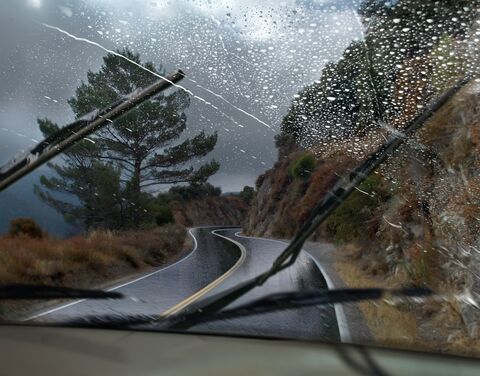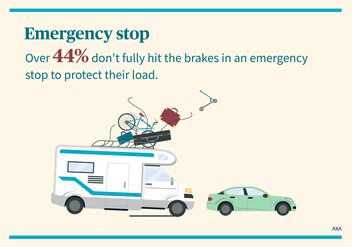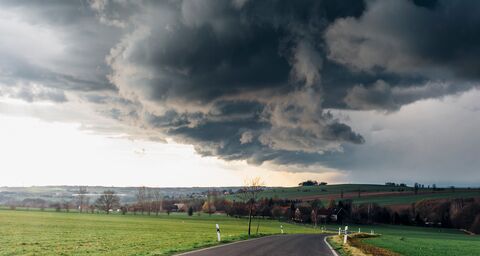
Driving an RV safely in bad weather
Dark clouds are gathering overhead, you're still a long way from your destination, and the wind's picking up. Experienced drivers of recreational vehicles (RVs) know that extreme weather conditions affect them much more than other motorists. Those who are new to RVs can find driving them in a summer or fall storm very challenging.
AXA Research & Prevention offers some helpful tips to ensure a safe journey even in difficult conditions.
Bad-weather driving tips for RV beginners
You naturally want the best possible weather for your RV vacation, but that's far from guaranteed. On the contrary: the summer often brings sudden storms and downpours, the fall strong winds and fallen leaves.
You need to be prepared, especially if you've only just got into RV motoring. Experience counts for a lot in bad weather and difficult driving conditions as an RV responds to heavy rain and persistent or gusting winds differently than a car.
A strong wind can cause your RV to sway from side to side because its center of gravity is comparatively high. Interior fittings like wardrobes and beds amplify this effect, and it can even cause the vehicle to tip over,
but there's no need to panic because there are safety precautions you can take to stop this happening. Read on for our top bad-weather tips.
General tips for RV safety in extreme weather
- Remember the difference in size and weight between an RV and a car, and keep this in mind on a windy day.
- Drive more slowly and defensively all the time.
- Take a special course to get a feel for how to drive an RV safely.
- Keep up to date on the weather so you can be ready if it's going to be bad. Listen to the forecast on the radio or check your weather app before you set off.
- Close windows and skylights and take care of any exterior blinds.
Driving safely in heavy rain
- Make sure your wiper blades are clean and your washer fluid reservoir is full.
- On soft or slippy surfaces like mud, a grip mat or other traction aid can help to prevent wheelspin. You can find them in hardware and auto accessory stores.
- Check that your tires have enough tread depth to prevent aquaplaning.
- You can buy mechanical or digital gauges to measure tread depth in any hardware store. A quick alternative is to use a two-franc coin. Push the coin into the tire tread. If it covers Helvetia's plinth, the tread depth is about 4 mm, which is enough. Measure the depth in several places because the tire might not be evenly worn. If you're unsure, ask a mechanic to help you.
- Try to avoid critical situations like rear-end collisions by keeping a safe distance behind the vehicle in front and thinking ahead. Remember that an RV has a longer braking distance than a car anyway, and wet roads make it even longer.
Get to know your vehicle
Practice emergency stops on a private road with no traffic. Better still, attend an RV driving course.
It's important not to be afraid to do a full emergency stop in a critical situation. A recent survey by AXA Research & Prevention revealed that 44% of Swiss drivers make the mistake of being too concerned about their load and thus failing to hit the brakes hard enough. They aren't concentrating on the most important thing: their own safety.

Driving an RV in strong winds
- Owing to their large side area, RVs are especially at risk in strong winds.
- If a sudden gust hits your RV, there's a big risk that you'll end up grabbing frantically at the steering wheel.
- A high wind can also push the RV out of its lane while you're overtaking bigger vehicles like trucks and buses.
- Gusts of wind can take you by surprise as you emerge from a wooded area or a tunnel or drive along a pass road or bridge.
- Some RVs have a side wind assistant that automatically activates the brakes when it detects a strong gust.
- If the wind gets too strong, you should pull over or find somewhere to park.
- In curves, you should keep plenty of distance and above all slow down.
Weathering the storm
- Most RVs have a plastic rain cover, and all have a lightning conductor. Nevertheless, it's not advisable to park on raised or broad and flat ground. If the body of your RV is made of metal, the safest place in a storm is the cab, which forms what is known as a Faraday cage that will even protect you from a lightning strike.
Extra tips for storms at the campsite:
- Retract any aerials or satellite dishes.
- Secure or retract any awnings and sun shades.
- Disconnect electrical cables from the mains to prevent power surges in the event of a lightning strike.
- Whatever you do, don't take a shower or wash your dishes.
Get the right coverage for rain and bad weather
Camping in bad weather can bring unexpected challenges and risks, from your RV breaking down to having to cut your trip short. This is where travel insurance can be really helpful: it can cover the cost of damaged equipment or lost bookings and provide assistance in an emergency, giving you the peace of mind to enjoy your camping trip, whatever the weather.





